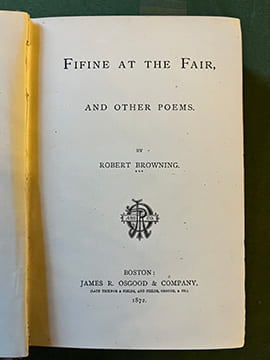by Anna Clark, Master’s Candidate in History and Armstrong Browning Library Graduate Research Assistant
This fall, the Armstrong Browning Library & Museum is hosting “Mythic Women: Archetypal Symbology in ‘Fifine at the Fair,'” an exhibition exploring the topics of sexual desire, social class, and the male objectification of women in Robert Browning’s 1872 poem “Fifine at the Fair.” This exhibit was curated by Katrina Gallegos, a Master’s student of Museum Studies at Baylor University. Gallegos’ exhibit is on display in honor of the poem’s 150th anniversary from August 17, 2022 – February 15, 2023* (date extended).

The Victorians are remembered for being conservative—in their dress, their customs, and their culture. Therefore, it is surprising to see provocative subjects explored in Victorian art, literature, and poetry. Victorians explored topics such as desire, infidelity, gender, and sexuality, and used their art as an expressive outlet in response to a restrictive society.
Because of the conservative nature of the dominant social culture, authors and artists used coded language to express their inner desires, thoughts, and emotions. This coded language often employed classical symbols from Roman and Greek antiquity. Victorians also used this coded language to prove their intellectual prowess among their peers. For modern readers and viewers, these examples may not seem provocative because the authors and artists used complicated language and obscure references. Some memorable authors and artists who employed provocative language and themes were Robert Browning, Dante Gabriel Rossetti, Lord Byron, and Julia Margaret Cameron.
Katrina Gallegos’ exhibit Mythic Women: Archetypal Symbology in “Fifine at the Fair” decodes the complex language found in Browning’s poem, “Fifine at the Fair,” specifically, examining the themes of sexuality, desire, the male gaze, and social class on the poem’s 150th anniversary.
Gallegos is a graduate student at Baylor University pursuing her Master’s degree in Museum Studies. Employing her interest in symbology, Gallegos’ exhibit explores Greco-Roman symbols she uncovered through her analysis of Browning’s poem and how these symbols connect to the topics of sexuality, desire, and male objectification of women in the late 19th century.

Helen of Troy, one of the mythic women symbolized in the poem
Particularly, Gallegos explains the symbols Robert Browning employs to describe the three central characters of the poem: Don Juan, Don Juan’s staid wife Donna Elvire, and Fifine, the exotic gypsy woman who is the object of Don Juan’s sexual desire.
Gallegos’ exhibit will be on display in the Hankamer Treasure Room from August 17th through February 15th, 2023. We invite you to visit this exhibit to explore the symbols in Browning’s work and reflect on the enduring legacy of “Fifine at the Fair” 150 years after its publication.
If you are not familiar with the poem or would like to refresh your memory, we have attached a hyperlink to a first edition copy of Browning’s “Fifine at the Fair” for your convenience: #3 – Fifine at the fair : and other poems / By Robert Browning. – Full View | HathiTrust Digital Library.

Frontispiece of the 1872 edition of Browning’s “Fifine at the Fair”
Read more in this series of blog posts about the exhibit “Mythic Women: Archetypal Symbology in ‘Fifine at the Fair'”:
